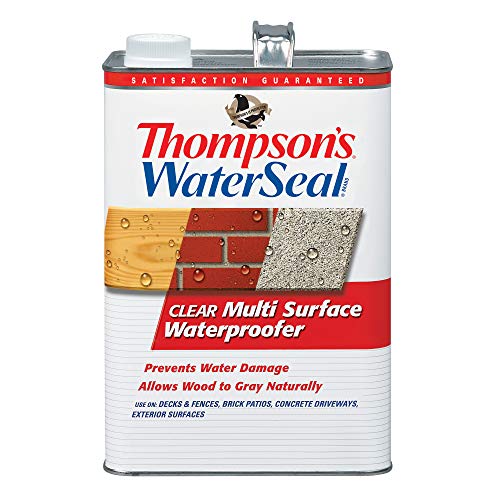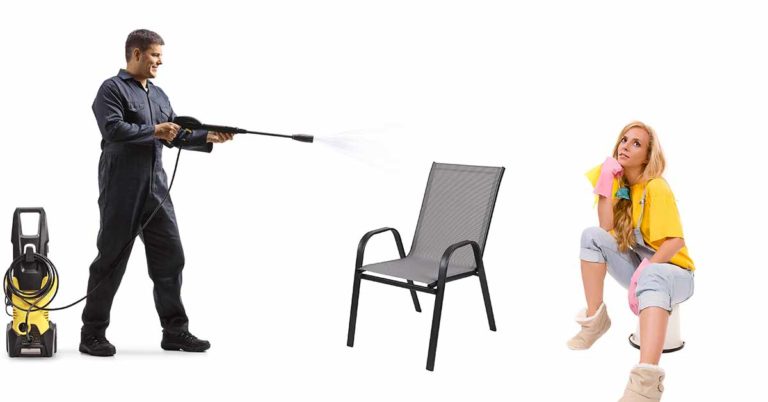Waterproofing Wood Furniture For Outdoors: Easy Steps to Keep New
If you want your wooden outdoor furniture to last longer, you need to take steps to protect it from water damage. One of the best ways to do that is by waterproofing it.
By waterproofing your wooden furniture, you can protect it from the elements and extend its lifespan.
Whether you have a wooden bench, a table, or a set of chairs, our guide will walk you through waterproofing your furniture.
How Does Water Affect Wood?
Water can damage untreated wood, especially if exposed to moisture for a long time.
Moisture can lead to warping, cracking, and rotting. It can be especially problematic for wooden outdoor furniture, which is often exposed to rain, snow, and other forms of moisture.
Waterproofing (a protective coating or sealant) can help to prevent water from penetrating the surface.
How to Waterproof Wood Furniture for Outdoors
Waterproofing Wood With Oil – Traditional Method
To waterproof with oil, you can use linseed oil (or Tung oil) to create a beautiful and protective surface.
- First, clean the surface thoroughly and let it dry completely. If needed, sand the surface to remove rough spots or old finishes.
- Then, apply a thin layer of oil onto the surface using a paintbrush. Make sure to cover the entire surface evenly.
- Let the oil soak into the wood (depending on the product, about 20-60 minutes).
- Then wipe off any excess oil with a clean cloth.
- Repeat this process a few times until the wood is fully saturated with the oil.
Allow the oil to dry completely (it might take up to 24 hours) before using it outdoors.
Linseed oil can darken the boards and bring out the natural grain. The extent of the color change will depend on the type of wood and the amount of oil applied. Depending on your preference, it might not be the ideal finish for light-colored bits (like ash and maple).
- 🌱 UNLEASH THE BEAUTY OF YOUR OUTDOOR WOOD WITH TEAK OIL: Our premium wood finish…
- GOOD HOUSEKEEPING SEAL: This product was evaluated by the Good Housekeeping institute and after rigorous testing by their expert scientists and engineers, has been granted the…
- Paint Brush Set Includes 1 Ea of 1″ Flat, 1-1/2″ Angle, 2″ Stubby Angle, 2″ Flat & 2-1/2″ Angle
- Paint Brushes For Interior Or Exterior Projects. Use Angle Sash Paint Brush For Cutting Crisp Lines.
- 𝐔𝐥𝐭𝐢𝐦𝐚𝐭𝐞 𝐕𝐞𝐫𝐬𝐚𝐭𝐢𝐥𝐢𝐭𝐲 – From cleaning to polishing and woodworking,…
DIY Danger: Oily Rags Can Be a Fire Hazard
The linseed oil on a cotton rag can catch fire at as low as 120 degrees with no outside spark.
The best way to dispose of oily rags is to lay them flat to dry in a well-ventilated area away from the sun.
Once the rags are dry, they can be disposed of (don’t use the same rags again).
Never leave oily rags piled up or crumpled together, as this can increase the fire risk.
How to Waterproof Wood With Sealant – Most Effective Way
Synthetic alkyd resins (lacquer, polyurethane, and varnish) have often replaced the traditional oil method (although linseed oil is returning thanks to its non-toxicity).
These synthetics form a film on top of the surface (when oil seeps into the grain).
To waterproof wood with sealant:
- Clean the surface and sand to remove rough spots or old finishes if needed.
- Use a brush or sprayer to apply a sealant to the surface. Make sure to cover the entire surface evenly.
- Allow the sealer to dry completely (it can take a couple of hours) before applying a second coat.
- Repeat the process until the desired level of additional coats is achieved. Re-sand if needed before recoating.
It’s important to note that different types of sealants may require other application methods and drying times, so it’s best to follow the manufacturer’s instructions carefully.
Pros and Cons of Different Sealants
Lacquer
- Pros: a durable and protective finish, dries quickly, easy to repair.
- Cons: flammable; creates an orange tint on lighter woods; easily damaged by strong solvents or detergents.
Polyurethane
- Pros: a thick, waterproof finish; no yellowing; water-based dries quickly; oil-based is resistant to scratches and wear.
- Cons: can soften in extreme heat or cold temperatures; mineral spirits needed to clean brushes (with oil-based polyurethane)
Varnish
- Pros: easy to apply and maintain; water-resistant; marine varnish gives UV protection to resist sun damage.
- Pros: can break down in direct sunlight; requires regular maintenance; can cause yellowing in certain woods over time.
To minimize yellowing, try to avoid harsh sunlight. Don’t leave plastic items, like vinyl tablecloths, on the table (especially on lacquered planks).
For a finish that isn’t yellowing, consider a water-based finish based on acrylic or non-yellowing polyurethane.
- Dries to the touch in 30 minutes, ensuring a smooth, dust-free finish
- Requires no sanding between coats
- Great for woodwork, cabinets, furniture, doors, accessories
- Protects outdoor wood surfaces such as furniture, fences, railings, trim and more
- Ideal for use on exterior wood surfaces above the water line, including trim, railings and wood furniture
- Set includes 1 each 3 inch Flat and 2-1/2 inch Angle Home Brush Set….
How to Waterproof Wood With Stain and Sealer – The Prettiest Way
Waterproofing with stain and sealer can enhance the natural beauty of the boards by highlighting their grain and color. And it is easy with pre-mixed stain and sealer products:
- Clean the surface (sand any rough spots or imperfections).
- Next, apply a coat of stain and sealer using a brush or spray. Be careful to cover all surfaces evenly.
- Follow the manufacturer’s instructions for application and drying time.
- Allow the surface to dry completely (up to 2 days) before using or storing the furniture outdoors.
Repeat this process as needed to maintain the waterproofing over time.
Waterproofing wood with stain and sealer can be time-consuming and requires regular maintenance.
Stains and sealers can also change the appearance, potentially making it darker or altering its natural color.
Additionally, some types of stains and sealers may contain chemicals that can harm the environment, so choosing an eco-friendly product is essential if possible.
- WATERPROOFING STAIN – Bring out the beauty of your outdoors with Thompson’s WaterSeal Clear Multi-Purpose Waterproof…
- CLEAR STAIN – This outdoor wood stain and sealer provides a clear finish. It will hide the grain, but still allow the…
- FADE RESISTANT FINISH – The advanced polymers in this outdoor wood and deck stain deliver fade-resistant color so it stays…
- PAINT SPRAYER FOR COUNTLESS DIY PROJECTS: The HomeRight Super Finish Max paint sprayer offers the ultimate DIYing experience….
Quick Tips for Waterproofing Wood
Some quick tips for waterproofing wooden furniture outdoors include using a waterproof sealant, applying a coat of oil-based paint, using a waterproofing spray, or using a combination of these methods.
It’s also essential to properly prepare the surface before applying any waterproofing treatment, such as sanding and cleaning the surface thoroughly.
Additionally, it’s a good idea to regularly maintain and reapply waterproofing treatments to ensure the furniture stays protected from moisture and the elements.
FAQ – Frequently Asked Questions
How Often Should You Oil Wood Furniture?
It depends on the type of wood and the level of exposure to the elements.
Still, generally, it’s recommended to oil wood furniture every 6-12 months to maintain its waterproofing and protect it from weather damage.
How Do You Seal Wood Without It Getting Darker?
One way to seal wood without darkening is to use a clear, water-based polyurethane outdoor sealant.
This type of sealer will not darken the boards like oil-based sealers can.
It is vital to apply the sealer evenly and follow the manufacturer’s instructions for drying time and the number of coats needed.
Does Paint Protect Wood Outdoors?
Yes, paint can protect wooden outdoor pieces by providing a barrier that prevents water from penetrating the surface. However, paint can also crack and peel over time, allowing water to seep in and damage the furniture.
It is essential to use paint specifically designed for outdoor use and to properly prepare and prime the surface before painting to ensure maximum protection.
So while painting can be a valuable protective measure, it could be more foolproof and may need to be reapplied periodically.
Other methods like sealing and staining may also help protect wooden furniture for outdoor use.
How Do I Maintain My Outdoor Wood Furniture?
Regular cleaning helps to maintain wooden outdoor pieces. Use mild soap and water solution, and avoid harsh cleaning products or power washers.
Protecting the outdoor furniture from the elements using outdoor furniture cover or waterproofing sealant is also essential.
Additionally, it is recommended to reapply the sealant every year to ensure continued protection against moisture and UV rays.
Choosing The Right Type Of Wood
Cedar, teak, and redwood are popular choices for outdoor furniture as they have natural oils and resins that protect the wood from water damage.
Other options include pressure-treated pine and acacia, which can also withstand exposure to the elements.
Softwoods like pine or spruce are more susceptible to decay when exposed to moisture. If you choose a softer variety, treat it with a waterproofing sealant to protect it from the elements.
Can You Use Indoor Wood Furniture Outdoors
Indoor furniture is not recommended for outdoor use as it is not designed to withstand the elements.
Moisture, sunlight, and temperature changes can cause indoor wood furniture to warp, crack, and become discolored. Seal and protect the surface with a waterproof finish.
To use wooden furniture outdoors, choose durable hardwood resistant to decay, such as teak or cedar.
The Bottom Line
Waterproofing your outdoor wood furniture can be a simple and effective process.
Whether you want to protect your investment or extend your furniture’s life, sealing and maintaining your pieces will pay off in the long run.
Read more: How To Clean Teak Outdoor Furniture (DIY Tips to Teak Care and Restore)












